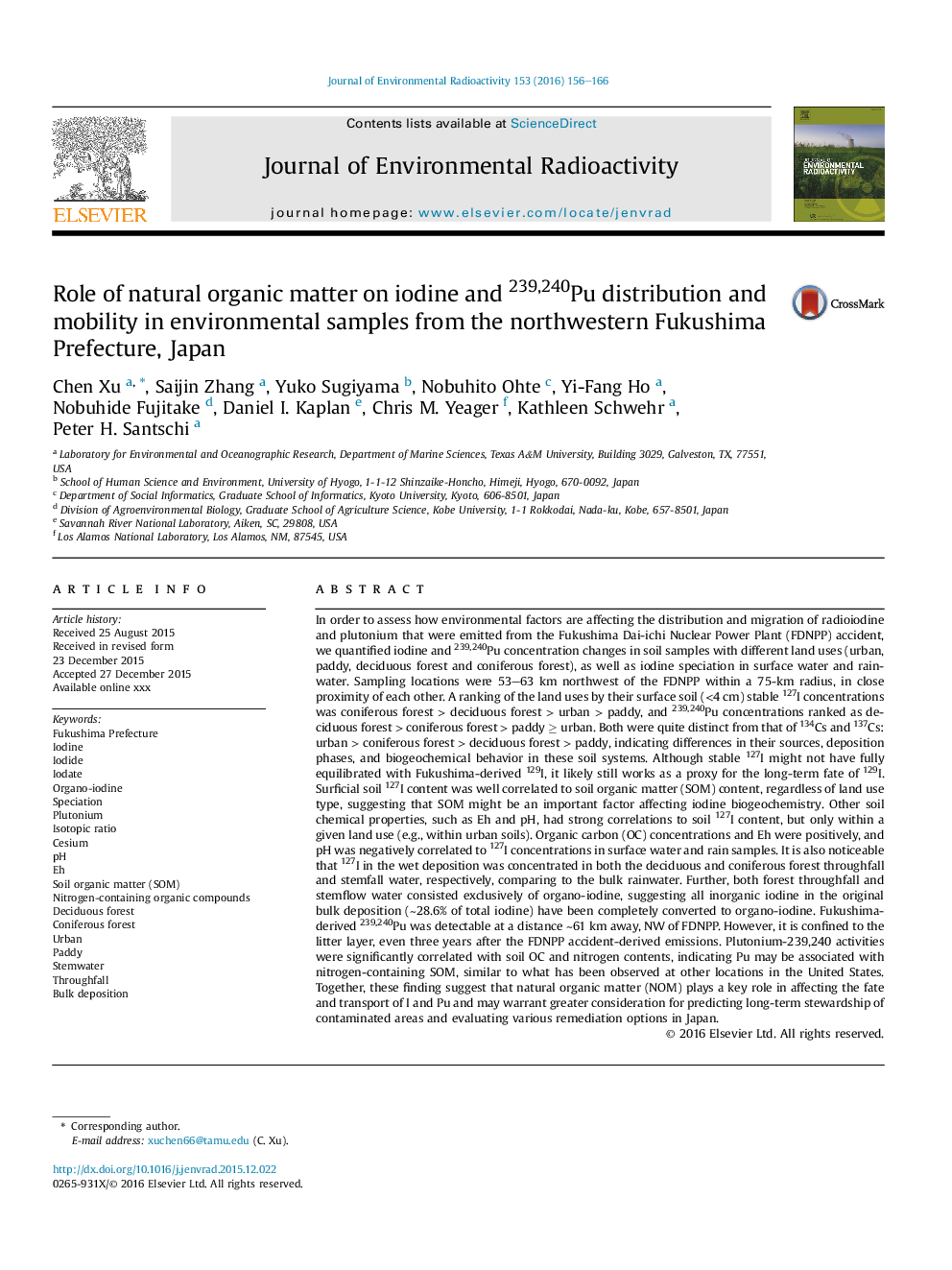| کد مقاله | کد نشریه | سال انتشار | مقاله انگلیسی | نسخه تمام متن |
|---|---|---|---|---|
| 8082038 | 1521581 | 2016 | 11 صفحه PDF | دانلود رایگان |
عنوان انگلیسی مقاله ISI
Role of natural organic matter on iodine and 239,240Pu distribution and mobility in environmental samples from the northwestern Fukushima Prefecture, Japan
دانلود مقاله + سفارش ترجمه
دانلود مقاله ISI انگلیسی
رایگان برای ایرانیان
کلمات کلیدی
Organo-iodine - ارگان یدNitrogen-containing organic compounds - ترکیبات آلی حاوی نیتروژنConiferous forest - جنگل درختانDeciduous forest - جنگل های بافتنیBulk deposition - رسوب بزرگCesium - سزیم، سیزیمThroughfall - سقوطUrban - شهرسازیSoil organic matter (SOM) - ماده آلی خاک (SOM)Isotopic ratio - نسبت ایزوتوپPaddy - پدیPlutonium - پلوتونیومSpeciation - گونه زاییIodine - یدIodide - یدید Iodate - ییدات
موضوعات مرتبط
مهندسی و علوم پایه
مهندسی انرژی
انرژی هسته ای و مهندسی
پیش نمایش صفحه اول مقاله

چکیده انگلیسی
In order to assess how environmental factors are affecting the distribution and migration of radioiodine and plutonium that were emitted from the Fukushima Dai-ichi Nuclear Power Plant (FDNPP) accident, we quantified iodine and 239,240Pu concentration changes in soil samples with different land uses (urban, paddy, deciduous forest and coniferous forest), as well as iodine speciation in surface water and rainwater. Sampling locations were 53-63 km northwest of the FDNPP within a 75-km radius, in close proximity of each other. A ranking of the land uses by their surface soil (<4 cm) stable 127I concentrations was coniferous forest > deciduous forest > urban > paddy, and 239,240Pu concentrations ranked as deciduous forest > coniferous forest > paddy â¥Â urban. Both were quite distinct from that of 134Cs and 137Cs: urban > coniferous forest > deciduous forest > paddy, indicating differences in their sources, deposition phases, and biogeochemical behavior in these soil systems. Although stable 127I might not have fully equilibrated with Fukushima-derived 129I, it likely still works as a proxy for the long-term fate of 129I. Surficial soil 127I content was well correlated to soil organic matter (SOM) content, regardless of land use type, suggesting that SOM might be an important factor affecting iodine biogeochemistry. Other soil chemical properties, such as Eh and pH, had strong correlations to soil 127I content, but only within a given land use (e.g., within urban soils). Organic carbon (OC) concentrations and Eh were positively, and pH was negatively correlated to 127I concentrations in surface water and rain samples. It is also noticeable that 127I in the wet deposition was concentrated in both the deciduous and coniferous forest throughfall and stemfall water, respectively, comparing to the bulk rainwater. Further, both forest throughfall and stemflow water consisted exclusively of organo-iodine, suggesting all inorganic iodine in the original bulk deposition (â¼28.6% of total iodine) have been completely converted to organo-iodine. Fukushima-derived 239,240Pu was detectable at a distance â¼61 km away, NW of FDNPP. However, it is confined to the litter layer, even three years after the FDNPP accident-derived emissions. Plutonium-239,240 activities were significantly correlated with soil OC and nitrogen contents, indicating Pu may be associated with nitrogen-containing SOM, similar to what has been observed at other locations in the United States. Together, these finding suggest that natural organic matter (NOM) plays a key role in affecting the fate and transport of I and Pu and may warrant greater consideration for predicting long-term stewardship of contaminated areas and evaluating various remediation options in Japan.
ناشر
Database: Elsevier - ScienceDirect (ساینس دایرکت)
Journal: Journal of Environmental Radioactivity - Volume 153, March 2016, Pages 156-166
Journal: Journal of Environmental Radioactivity - Volume 153, March 2016, Pages 156-166
نویسندگان
Chen Xu, Saijin Zhang, Yuko Sugiyama, Nobuhito Ohte, Yi-Fang Ho, Nobuhide Fujitake, Daniel I. Kaplan, Chris M. Yeager, Kathleen Schwehr, Peter H. Santschi,